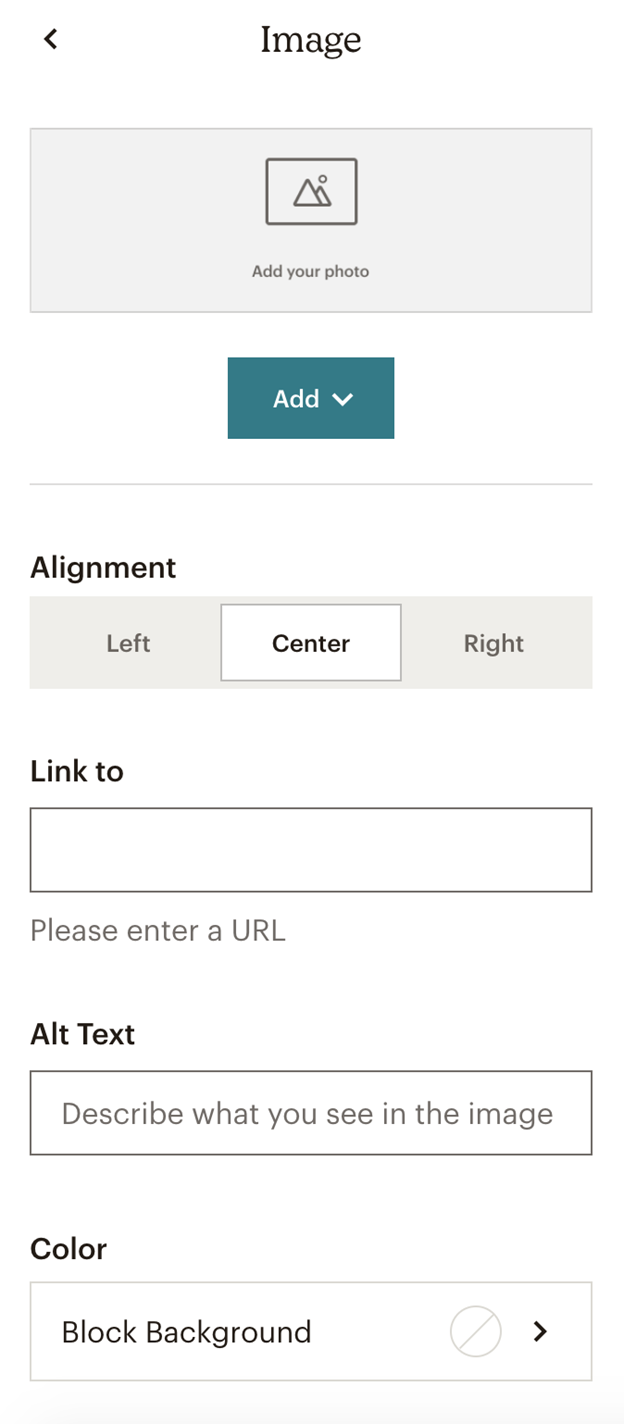Effective advertising almost always includes a robust email marketing strategy, regardless of the type of business. Emails are somewhat inexpensive to produce yet reach a wide audience in a quick and efficient way. Using email, you can communicate the latest developments from your company, announce a limited time offer or share your latest blog content.
Email newsletters are one of the most common email marketing tools, providing a "one-stop-shop" approach to increasing engagement and conversion. In this guide, we'll explain the benefits of email newsletters and how to craft an effective campaign so you can take your marketing efforts to the next level.
What is an email newsletter?
An email newsletter is a communication sent on a regular basis that is intended to nurture contacts in an interactive way. They let subscribers know what's new and exciting while simultaneously inviting them to engage with your company. Newsletters should not be overly salesy, as that may alienate your audience. Consider them as a form of "advertainment" – content that should inform consumers about products and services in a fun, approachable way.
Newsletters should provide added value for recipients by offering relevant information and deals. Try to put yourself in your customers' shoes: What would you want to know about your company or the industry you are in? For example, if your business sells electronics, featuring exciting news about new innovations may pique readers' interest, thereby increasing the likelihood that they'll read further (and open future communications from you).
Editor's note: Looking for the right email marketing service for your business? Fill out the below questionnaire to have our vendor partners contact you about your needs.
Why do businesses send email newsletters?
There are several benefits you can gain by deploying an email newsletter strategy. First, consistent communications help ensure that companies stay relevant with their subscribers while building rapport. Second, it's a great way to boost website traffic via embedded links to your web content – and, of course, a third benefit of email newsletters is that they help you generate sales.
A fourth benefit of sending email newsletters is the relatively low cost associated with production. Aside from labor costs and a subscription fee for an email marketing service, email newsletters are still less expensive than other advertising methods, such as print or pay per click. And with the average American checking their email inbox multiple times throughout the day, you have a higher chance of engaging with your target audience.
A fifth benefit of email newsletters is that they provide metrics, which are useful for digital marketing teams to analyze to improve future campaigns. Open rates, click-through rates, and bounce rates are key performance indicators and can provide insight into how subscribers interact with your content. These email analytics are powerful tools, so they should be reviewed regularly to help you increase conversions.

How to create an email newsletter
Crafting an engaging yet informative email newsletter doesn't have to be difficult. The steps below outline how to create and send a newsletter. (Be sure to read on for the best practices when sending an email newsletter).
- Choose which email marketing service you'd like to use. Email marketing services provide a one-stop-shop solution perfect for businesses big and small. The software is easy to learn and use, plus you get several templates you can easily customize to create your newsletter. They will also help you keep track of whom you're communicating with and how your messages are performing. Some of the most widely used options include Mailchimp, Sendinblue, Constant Contact and GetResponse.
- Curate a contact list. An email list contains the contact information of people who have consented to receive communications from you. There are many creative ways to grow your email list numbers, but one thing to avoid is buying a list, as they almost always contain outdated information and have spam traps buried inside them.
- Provide segmentation. Having a robust list of subscribers is a great start, but understanding who they are can lead to even better results. Segmentation is the act of grouping contacts together based on certain criteria. It may be demographics-based, such as location or age, or it can relate more to purchase history or self-identified interests.
- Determine the target and your objectives. Now that you have selected an email marketing service and segmented your list, you can plan your newsletter. First, start by setting your goals and objectives for your newsletter – are you trying to push recipients toward a certain webpage? What metrics will you use as your key performance indicators? Outlining what you want to achieve with your newsletter prior to designing it can streamline the process and boost the effectiveness of your messaging.
- Build your newsletter content. With your objectives in mind, you can now move to the next step in the process: planning what information you will include in your newsletter. If you are starting your newsletter from scratch, you may want to pick some regular features that will appear in subsequent newsletters. This could include a featured blog, a quiz and/or the latest news. Make sure to include plenty of links to your website and social media accounts, offering multiple chances for the recipient to interact. Strong calls-to-action (CTAs) within linked buttons or boxes also bode well for engagement. Most businesses send their newsletter to all of the subscribers on their email list, but you may want to tweak the content of your newsletter slightly depending on different segments of your audience. Once you've added your images and proofread your newsletter thoroughly, it's ready to go!
- Schedule your send. Deciding when to send your email newsletter is a crucial part of your strategy. Several surveys have been conducted on the best time to send marketing communications, and it has been determined that in most cases, the earlier part of the traditional workday (between 8:00 a.m. and 11:00 a.m.) has the best chance for engagement. As far as the best day of the week, Tuesdays and Thursdays have been identified as top performers, especially if they fall on the fifth, seventh or 12th day of the month.
- Analyze the results. Email newsletters provide important metrics that should be evaluated carefully to determine successes and identify areas for improvement. Which parts of the newsletter did consumers click on the most? Were there deliverability issues? Which of your segments engaged the least? All of these questions should influence future campaign planning. Your team should consider using A/B testing (wherein slightly different versions of the same email are sent at the same time) to further understand audience behavior and preferences. Many email marketing services offer A/B testing with their service.
Email newsletter best practices
With so many companies sending email newsletters, it can be challenging to stand out. Here are some best practices to follow that can help you maximize results.
- Create a landing page. Having a dedicated page on your website where visitors can opt in to receive communications from you. This tactic will help increase your subscriber base and prevent spam designations. A newsletter landing page can also be shared on social media to boost list growth. Make sure you add strong SEO components to drive more traffic to your site and increase your newsletter's audience.
- Keep it simple. Email newsletters are intended to update and nurture your contacts, but don't overload them with information, no matter how pertinent it is. Longer messages may rub recipients the long way, and they likely won't even read the entire thing anyway: 55% of Americans say they skim emails.
- Format your newsletter for multiple devices. Most of your recipients will intercept your newsletter on a mobile device or tablet. Therefore, as you design your newsletter, use one-column templates to ensure emails are easy to scroll, and always preview your newsletter in different device modes to see how it will look on a phone versus a desktop computer. (Most email marketing services have a feature that allows you to toggle between device views).
- Use a strong subject line. First impressions matter. Your newsletter subject line is your one chance to make an impact and convince the recipient your email is worth opening. Keep your subject lines short and sweet (between five and eight words ideally), but make sure it conveys what your newsletter is about. Consider adding the contact's first name to the subject line. Subject lines are a worthy element to A/B test, so consider testing subject lines to gauge what your audience prefers.
- Be consistent. You want to commit to regularly sending your email newsletter to your audience. Sporadic communications will confuse subscribers, and they could trigger spam filters. At the same time, you don't want to bombard your audience with communications from you. Send your newsletter at least once per month, but not more than once per week. Additionally, stick to the same format so your contacts know what to expect.
- Don't act like a spammer. Newsletters are meant to encourage engagement and conversion. Unfortunately, missteps can lead to recipients (or their email service providers) assuming your friendly communication is yet another spam message. Avoid spam trigger phrases such as "apply now" or "buy direct," and instead use language that's relevant to your industry and your audience's interests.
Email newsletter templates
As we mentioned earlier, most email marketing services offer templates. This allows you to drag and drop images, copy and paste text, and insert buttons for linking to your website.
These are some examples of templates in Mailchimp, a popular email marketing software for small businesses, but there are many other types of software out there – see our buying guide to determine which is right for you.
Sample No. 1: 'Bold'
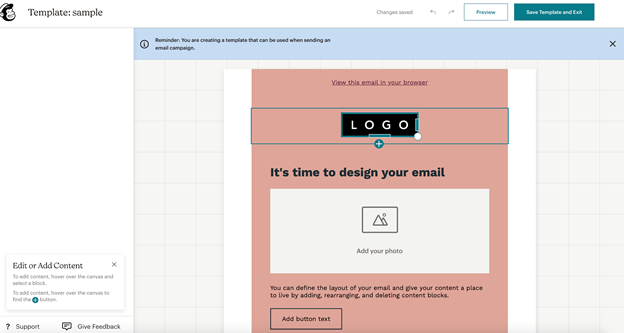
Mailchimp makes it extremely simple to customize their templates. This "bold" template (which offers several options for the background color) automatically includes space for your company logo, a headline, image, text, and a button link for a CTA.
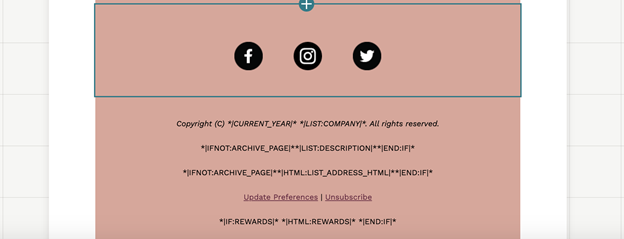
Each Mailchimp template also has a place to link to your social media accounts, as well as a footer for pertinent company information and legal disclaimers.
You can add content by hovering your mouse where you would like to insert content. A blue plus sign ( "+") will pop up. Click the sign and a menu of content options, such as video, text, photo, etc., appears. Select the asset you want to add, and it will populate into the field.
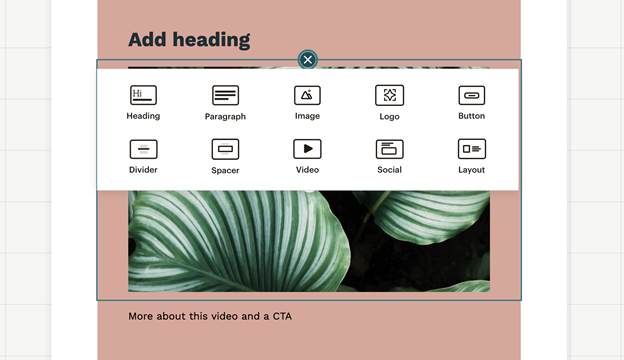
Depending on the type of content you want to add, a sidebar may appear, which asks you more questions about the asset, such as the URL you want a button to link to or a description of the video you want to upload.
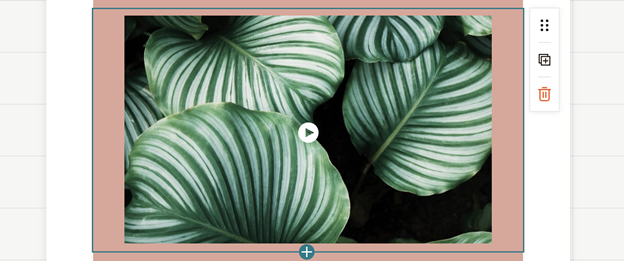
To change the color of the background, hover your mouse over the background, click on it, and you can then choose the color option you prefer.
Sample No. 2: 'Natural'

The natural template is another Mailchimp option. It features muted earth tones, like forest green and sandy tan, that don't distract from your message. Using this template, you drag and drop content blocks to get the configuration you prefer.
Sample No. 3: 'Gallery'
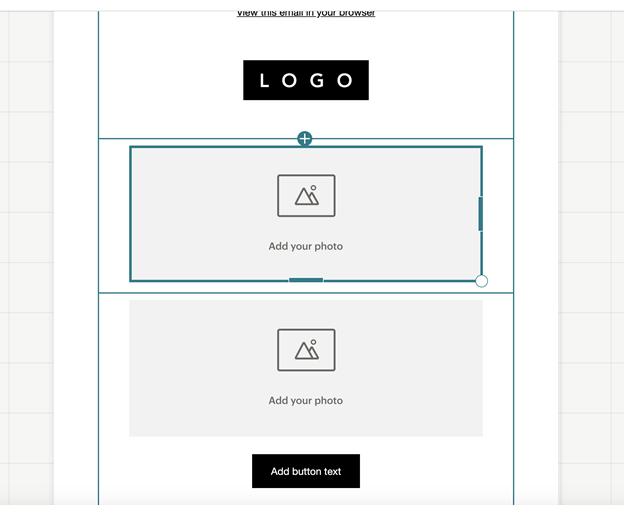
Mailchimp's "Gallery" option is a more image-heavy template, perfect for e-commerce companies or media outlets. This template features a white canvas and backdrop to make your pictures pop, but shades of gray, blue, and green are available.
Here's how changing the color of the backdrop can instantly change the look and feel of your newsletter:
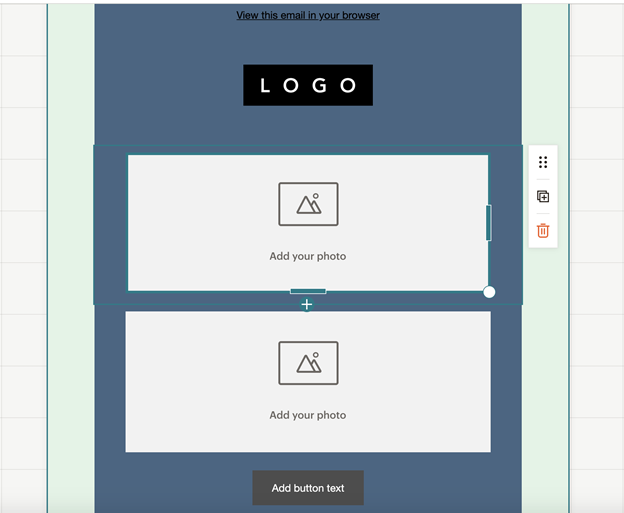
Last, make sure you add images to increase interaction and boost conversion. Below is the screen that pops up when you click on "Add your photo." You can choose the alignment of the photo, and if the images are on your company website, you can add the URL.
